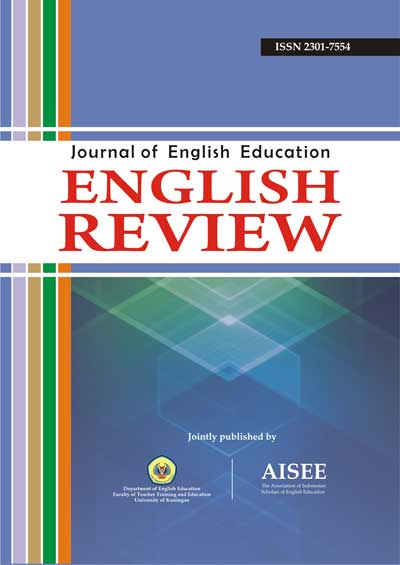MULTIMEDIA-BASED ACTIVITY IN YOUNG LEARNERS’ ENGLISH CLASS: IMPLEMENTATION AND OUTCOME
Abstract
Abstract: This research aims at investigating how multimedia facilitates young learners’ learning English. The study utilized a descriptive method. This comprised observing, collecting data, classifying data, and analyzing data. Observation to the multimedia is carried out to seek for steps of lessons and the steps are facilitating young learners leaning. The subjects in this study were series of multimedia programs. The results showed that the multimedia programs have presented to five young learners’ learning traits in designing the lessons. Those traits were transferred in terms of activities presented into stages, time allotment/duration, having specific topic, providing songs and funny cartoon characters and scenes, and materials recycling in the lessons. Thus, it can be concluded that the use of multimedia program is beneficial and recommended either in a classroom as a supplementary activity, at home for home learning or watch for fun.
Keywords:Â multimedia, young learners, learning traits
References
Alwasilah, A. C. (2002). Pokoknya kualitatif. Bandung: Pustaka Jaya.
Ashworth, M. & Patricia, W. (2005). Teaching the world’s children ESL for ages three to seven. English Teaching Forum, 43(1), 2-7.
Brown, H. D. 2000. Teaching by principles: An interactive approach to language pedagogy. New York: Longman
Creswell, J. W. (1994). Research design: Qualitative & quantitative approaches. California: Sage Publication, Inc.
Fillmore, L. W.& Catherine, S. (2000). What early childhood teachers need to know about language. Retrieved on 23 February 2015 from http www.ericdigests.org/2001-3/early.htm
Harmer, J. (2002). The practice of English language teaching. Kualalumpur: Longman
Klein, K. (2012). Teaching young learners. English Teaching Forum, 31 (2) Retrieved on 23 February 2015 from http//exchanges.stategov/forum/vol2/vol31/no2/pg14/htm.
Latha, R. H. (2005). A reading program for elementary schools. English Teaching Forum, 43 (1). (18-23).
Maxwell, J.A. (1996). Qualitative research design: An interactive approach. California: Sage Publication, Inc.
Musthafa, B. (2002) EFL for young learners. Bandung: Crest.
Musthafa, B & Wachyu, S. (1993). Teaching EFL learners sociolinguistics concepts for intercultural understanding. Retrieved on 23 February 2015 from files.eric.ed.gov/fulltext/ED397661.pdf.
Paton, J. (2002). Fostering second language development in young children. ESL Articles Collection. Retrieved on 10 May 2015 from http://www.1-language.com
Pinter, A. 2006. Teaching young language learners. Oxford: Oxford University Press.
Suyanto, K, K. E. 1999. Teaching english to young learners in Indonesia (p. 164-171). An article presented in National Seminar: The Development of TEFL in Indonesia. 1999.
Shin, J. K. 2006. Ten Helpful Ideas For Teaching English To Young Learners. English Teaching Forum, 44 (2).
Sinaga, M. 1994. Teaching English to children (as opposed to adults) (p.173-178) Presented in National Seminar: The Development of TEFL in Indonesia. 1994
Strauss, A and Corbin J. 1990. Basic qualitative research: grounded theory procedures and techniques. New York : Sage Publication.
Amato, R. and Patricia, A. 2003. Making it happen: from interactive to participatory language teaching. New York: Longman
Stempliski, S & Barry, T. 1990. Video in action: Recipes for using video in language teaching. London: Prentice Hall.
All articles published in English Review: Journal of English Education (ERJEE) are licensed under the Creative Commons Attribution 4.0 International License (CC BY 4.0).
Copyright Ownership
Authors retain the copyright of their articles and grant ERJEE the right of first publication. The journal is granted a non-exclusive license to publish, reproduce, and distribute the article in any format, medium, or platform, provided that proper credit is given to the original authors.
License Terms – CC BY 4.0
Under the Creative Commons Attribution 4.0 International License, others are free to:
- Share — copy and redistribute the material in any medium or format
- Adapt — remix, transform, and build upon the material for any purpose, even commercially
As long as they:
- Provide appropriate credit to the original author(s) and source
- Provide a link to the license (https://creativecommons.org/licenses/by/4.0/)
- Indicate if any changes were made
There are no restrictions on the reuse, reproduction, or adaptation of published articles as long as attribution is properly given.
Author Warranties
By submitting a manuscript to ERJEE, authors confirm that:
- The work is original and does not infringe any existing copyright.
- The manuscript has not been previously published and is not under consideration elsewhere.
- All sources and references are appropriately acknowledged.
- Necessary permissions have been obtained for any copyrighted materials used.










